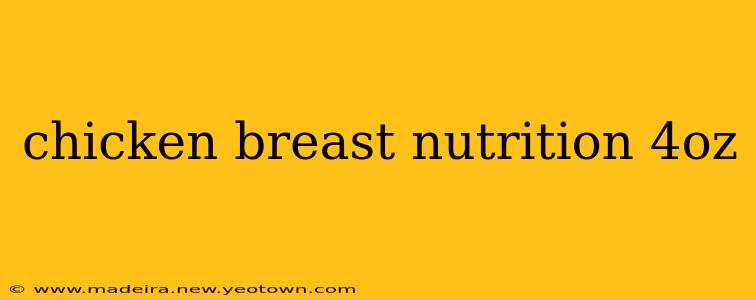Chicken breast: the diet staple, the fitness fanatic's friend, the culinary chameleon. But beyond its versatility, lies a nutritional powerhouse often underestimated. Let's delve into the specifics of a 4-ounce serving, exploring its benefits and answering some common questions.
Imagine this: you're meticulously planning your next meal, focusing on lean protein. You reach for that trusty chicken breast, already picturing the delicious possibilities. But what exactly are you getting nutritionally from that 4-ounce portion?
A 4-ounce cooked chicken breast is a remarkable source of high-quality protein, boasting approximately 30 grams. This protein is crucial for building and repairing tissues, supporting immune function, and keeping you feeling full and satisfied, aiding in weight management. It's the type of protein your body readily absorbs and utilizes effectively.
What are the benefits of eating chicken breast?
The benefits extend beyond just protein. Chicken breast is remarkably low in fat, particularly saturated fat, making it a heart-healthy choice. It's also a good source of several essential vitamins and minerals, contributing to overall well-being. Think niacin, which plays a vital role in energy metabolism; selenium, a powerful antioxidant; and phosphorus, essential for bone health.
How many calories are in 4 ounces of chicken breast?
This depends slightly on the cooking method. However, a 4-ounce serving of grilled or baked chicken breast typically contains around 165-190 calories. This relatively low calorie count, combined with its high protein content, makes it an excellent choice for those watching their weight or aiming for a calorie deficit.
Is 4 ounces of chicken breast enough protein?
For many, a 4-ounce serving provides a substantial portion of their daily protein needs. However, individual requirements vary significantly depending on factors like age, activity level, and overall health goals. Consult a nutritionist or registered dietitian for personalized recommendations to ensure your protein intake aligns with your specific requirements.
What are the best ways to cook chicken breast?
The key to enjoying chicken breast is finding cooking methods that retain its moisture and flavor. Grilling, baking, pan-searing, and poaching are all excellent options. Avoid overcooking, which can result in dry, tough meat. Experiment with herbs, spices, and marinades to add exciting flavors and elevate the culinary experience.
What are the downsides of eating too much chicken breast?
While generally healthy, consuming excessive amounts of chicken breast, like any single food source, can lead to nutritional imbalances. A diverse diet is always recommended to ensure you’re getting a wide array of vitamins and minerals from various sources. Overconsumption of protein can also strain the kidneys in some individuals.
Is chicken breast good for weight loss?
Absolutely! The high protein content promotes satiety, helping you feel fuller for longer and reducing overall calorie intake. The relatively low calorie and fat content further contributes to its effectiveness in weight loss diets. However, remember that weight loss is a holistic process involving diet, exercise, and lifestyle choices.
In conclusion, a 4-ounce serving of chicken breast offers a fantastic nutritional profile – a lean, protein-rich food that supports various aspects of health and well-being. Incorporating it strategically into a balanced diet can significantly contribute to your overall health goals, but remember to enjoy it as part of a varied and colorful eating plan. This isn't just about hitting nutritional targets; it's about savoring delicious, healthy meals that fuel your day.

